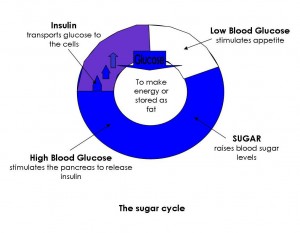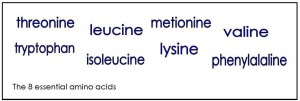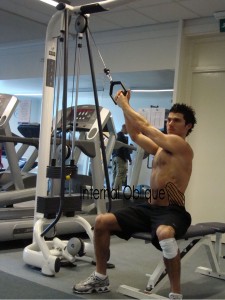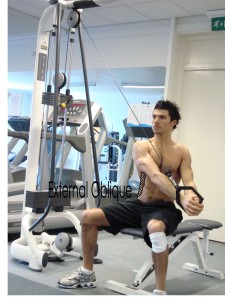Drop a Jean Size – For Good!!
You may have seen a certain cereal company run an advertising campaign with a similar title. The plan of action is to eat a bowl of cereal for breakfast and lunch followed by a normal evening meal. Whilst undoubtedly effective it is definitely not the ideal way to achieve sustainable weight loss. In fact, you could replace the cereal for pretty much anything of similar calorific value and achieve the same results. This is because the reason for the weight loss is a large reduction in daily calorific intake. The recommended serving size for this cereal is 1 cup (31g) and this provides 110 calories (with just under 15% of the calories coming directly from sugar). An average bowl of this cereal with semi-skimmed milk would provide 208 calories. A bowl for breakfast and another for lunch would provide 416 calories. Combined with an evening meal that provides roughly 750 calories will still only result in a daily intake of 1166 calories.
The NHS recommended daily allowance of calories is 2500 for males and 2000 for females, so is easy to see why people experience short-term weight loss following such a plan. That however, is the key term; ‘short-term weight loss’. As the initial loss relied so heavily on a drastic reduction in calories unless the daily intake remains at this level weight will start to creep back on.
In my humble opinion, a ‘diet’ by definition will not work. This is because they normally involve eating foods that we don’t enjoy, or require us to keep to a strict regime that cannot be realistically maintained. As well as these issues, a diet often ignores the fact that we are all different and require slightly different components to our nutrition. For example some people will feel they have more sustained energy levels eating a higher proportion of protein, whilst others may find eating this much protein makes them feel sluggish. This is due to our oxidative rate, the speed at which we ‘burn’ up the energy we receive from foods. Fast oxidisers often do better eating ‘heavier’ or ‘darker’ meats such as chicken legs and thighs whereas others with a slower oxidative rate will struggle to digest this and would prefer ‘lighter’ meats such as chicken breast. With a little experimentation it is possible to discover what works best for you as an individual.
Above all it is important that whatever changes to the diet are made, they become long-term changes that are realistic. Beneficial changes include:
Avoid Sugar
Sugar has one purpose and that is to provide us with ‘clean’ and readily available energy. It is devout of any nutrients, vitamins or minerals and supplies us with ‘empty’ calories. If our body does not require the amount of energy consumed then it is stored as fat.
Pictured below is what happens when we eat carbohydrates. A drop in blood sugar levels stimulates our appetite and we eat. The pancreas secretes a hormone called insulin which instructs our cells to absorb the sugars and store them as glycogen or as fat depending on the amount eaten and requirements at that time.

If the food we eat has a large amount of sugar our body will release a large amount of insulin. This can cause a sudden drop in our blood sugar levels as our cells respond and absorb the sugars. A sudden drop in blood sugar levels can cause hunger, fatigue, poor concentration, headaches, nervousness, irritability and depression. The short-term effect of this sudden drop often causes us to try and find a quick fix, usually something sweet to boost our blood sugar levels. This in turn only starts the same cycle again and so it goes on. It is easy to see why blood sugar levels can cause so many weight control issues.
Fat has got a lot of bad press and so has paved the way for many ‘low-fat’ products. A good example of this is the rise in popularity of cereal bars. Most cereal bars will advertise the fact they are extremely low in fat. This is very true, however they are usually packed full of sugar. In fact, they would probably be better off with more fat in them. At least the fat would slow down the release of all that sugar! As it is it, we are sent on a blood-sugar roller-coaster that will leave us feeling hungry again very quickly. A better choice for a snack between meals would be some raw vegetables (carrot dipped in humus for example) or a small handful of nuts.
Long-term blood sugar level imbalances are linked with diabetes. Diabetes is an extreme form of blood sugar imbalance and a serious health risk. It occurs when the body can no longer produce enough insulin. This results in there being too much glucose in the blood and not enough in the cells.
Eat vegetables with 2 meals per day
Vegetables are abundant in vitamins and minerals as well as providing high amounts of fibre and anti-oxidants. Vegetables can help to ‘bulk’ out a meal as they are satisfying to eat yet contain few calories. The fibre vegetables contain can decrease the risk of bowel cancer and diabetes by making faecal matter more bulky and easier to pass through the digestive tract. By reducing transit time it reduces the risk of infection. As vegetables are made up of so much fibre they can help to control blood sugar levels and help to keep our energy up for longer and prevent us from snacking on junk foods.
Eat protein with every meal
The word protein comes from the Greek word ‘protos’ which means ‘first’. Protein is the basic material of all cells and is required for there continued growth and repair. Protein itself is made up of amino acids, there are 25 in total. Of these 25, 17 can be produced by our body. The remaining 8 have to come from the foods we eat and are classed as ‘essential amino acids’.
Eating a meal containing protein helps to slow the release of energy into the blood stream. This helps to keep our energy levels balanced and reduces the risk of snacking on sugar-laden ‘quick fix’ foods. In conjunction with a balanced exercise programme, protein ensures our cells can be repaired and grow stronger. This has a direct effect on our metabolism and ability to use the energy we obtain from food. Protein is also more satisfying to eat then a meal containing large amounts of carbohydrates alone. This means we feel comfortably full quicker and therefore can prevent over-eating.
Protein can come in many forms, some of the best include:
- Meat – chicken, turkey, beef, pork.
- Fish/seafood – tuna, salmon, prawns, cod.
- Quinoa; a South American grain, unlike most other grains it contains all the essential amino acids and is classed as a ‘complete protein’.
- Dairy products – eggs, milk, cheese.
Exercise Regularly
We are kinetic beings and are designed to be active. Regular exercise can improve energy levels, improve digestion, reduce bodyweight, reduce body-fat as well as improve our mood and concentration levels.
Our body contains mechanisms to allow for extremely smooth and efficient movements. Take walking for example; when we take a step forward energy is stored through our posterior sling (a set of different muscles that connect one leg to the opposite arm) and is released as we take the next step. The process repeats with every step and makes movement much more energy efficient.
Unfortunately we are becoming much more sedentary and inactive. Technological advances have resulted in many of us spending hours in front of a PC or laptop. This does nothing for our posture, our weight or our health. By becoming more active we burn more calories every day, calories that could potentially be stored as fat.
Regular exercise can help ensure the energy we consume from food is not stored as fat. Exercise itself burns a lot of calories, especially if it is at a high intensity. High intensity training however requires a high level of fitness and should not be attempted by those who are not accustomed to regular exercise. What is more important is that the exercise becomes a regular occurrence, not a fad that lasts a month! With a regular exercise routine it is possible to be thinner, healthier and happier for good.
After exercise our metabolic rate (the rate at which we burn calories) is elevated. It is elevated for longer periods after weight training because of the direct effect on the muscles used but cardiovascular activity can also have a beneficial effect. During this period we are much less likely to store the energy we consume from food as fat.
Include resistance training
When we use resistance training our muscles are placed under a higher level of loading then they are used to. This can cause micro-tears within the muscles, as these tears are repaired by the body the muscle grows stronger and more toned. Effectively it is like replacing the engine in a car; imagine removing a 1.2 litre engine and replacing it with a 2.0 litre turbo! The result is the car burns more fuel with the new engine on every journey with increased performance!
As we increase the amount of lean tissue (muscle) within the body, it results in an increase in our RMR (resting metabolic rate – the number of calories our body’s burn at rest). This is extremely effective in maintaining sustained weight loss. By increasing our RMR the body requires more calories then it did before. It also becomes more efficient at using fuels and reduces the risk of storing energy as body-fat.
A common myth is that weight training will make women bulky. Whilst it is true women can become bulky with heavy weight training. It would require many hours of heavy weight training to achieve this. Using low to medium weights and high repetitions should result in increased muscle tone and RMR without any bulking what-so-ever.
Include transverse plane movements (rotation patterns)
Transverse plane movements rotate the torso and therefore activate the abdominal muscles either side of the trunk; these are called the obliques. The obliques have 2 parts, internal and external. The internal oblique run from the top of the pelvis to the 10th-12th ribs (pictured below – left). The external obliques run from the 5th-12th ribs down to the linea alba and the top of the pelvis (pictured below – right).
As these muscles become more toned they can act like a girdle or corset and literally take inches off the waistline. In the pictures below I am performing a woodchop pattern, a particularly effective exercise for targeting the obliques.
As I pull the cable across my body from right to left, I am activating the internal oblique on my left side and simultaneously, the external oblique on my right resulting in rotation of the trunk to the left. Sitting on a bench is a good way to perform the exercise for beginners as it fixes the pelvis and helps to ensure the correct muscles are used.
Food intolerances
We can eat as healthily as possible, choosing only the finest ingredients. However, if we cannot digest these foods they are pointless. Food allergies and intolerances are becoming more and more common among both children and adults. Most common among these are gluten, wheat and dairy intolerances. Symptoms may include abdominal bloating, pain, wind and diarrhoea.
It doesn’t take a genius to figure out that a bloated stomach is going to be bigger than a healthy, happy stomach. As well as bloating, intolerances can also interfere with our abdominal muscles ability to function properly. It also hinders our ability to gain the nutrients from food.
Examples of foods that contain gluten/wheat are:
- Porridge oats
- Most breakfast cereals
- Bread
- Pasta
Examples of foods that contain dairy are:
- Milk
- Eggs
- Yoghurt
- Cream
- Cheese
It would make sense that if we are suffering such strong reactions to any of these foods, we should try to avoid consuming them. This has been made much easier as supermarkets now stock a good range of wheat-free, gluten-free and dairy-free products. Most meals that we are used to eating can be replicated without any noticeable loss of taste with these products and they can make a big difference in how we feel day to day.
Do not avoid fat!
Fat itself does not make us fat. It is often a combination of factors that include consuming too many calories, too many bad fats and not getting enough exercise. Fat is an essential part of our diet, it is a structural component of cell membranes and is needed to produce many hormones that allow us to function at an optimal level. It is also required to absorb vitamins A,D,E and K.
Good fats include:
- Butter
- Cold pressed olive oil
- Coconut oil
- Lard
- Cold pressed flax oil
Bad fats include:
- Any hydrogenated oil
- Soy and safflower oils
- All fats that are not saturated when used at high temperature (as when frying).
Fat has 9 calories per gram compared with 4 calories per gram of carbohydrate and protein; so it is easy to see how a food that has a high percentage of fat can lead to weight gain. Most foods however that are high in fat can be very satisfying to eat and therefore we eat less of it. What can be much more damaging is if a food is high in both fat and sugar (cakes, sweet pastries, biscuits etc). If this is the case the foods is likely to be high in calories but because of the sugar content it will take longer for us to feel satisfied and we are more likely to over-eat.
Avoid alcohol
Alcohol can play havoc with the body’s blood sugar levels, causing them to rise rapidly and then crash. This triggers the powerful hunger response that often leads to the consumption of junk foods. Alcohol has a high calorific value with 7 calories per gram and can often come with sugary mixers. It also inhibits the body from burning energy from other sources. This is because the energy from alcohol cannot be stored and so must be used by the cells immediately. This in turn suppresses the oxidation of protein, fats and carbohydrates.
Eat fresh!
It seems like we are constantly losing precious time to do things. Time really is money for many people and so they rely on convenient pre-prepared, processed, packaged meals for their daily nutrition. Unfortunately they are often laden with sugars, excess sodium (salt) and trans fats (bad fats).
Processed convenience foods cannot compete with home-cooked meals. Whilst providing more nutritional value, you also know exactly what goes into them and most of all; they taste better! Busy life-styles may make it impossible to eat fresh all the time. However by taking steps to eat fresh as you can, as often as possible you will be increasing your vitamin and mineral intake and improve your chances of experiencing increased health, vitality, energy and sustained weight loss.
Conclusions
As you can see, there is no secret to dropping a jean size for good. It’s simply a case of avoiding certain foods, ensuring you have a balanced diet and get plenty of exercise. There is nothing wrong with eating ‘bad’ foods that we enjoy every now and then, in fact I think it’s very important to find a balance. If you eat well 80% of the time the remaining 20% of the time you can eat what you want and it shouldn’t make to much difference (providing you really do eat well and exercise the other 80%).
Above all else I feel the most important factor in achieving long-term weight loss is to make lifestyle changes that can be maintained.
Reference Material:
Anita Bean – 1996 – The Complete Guide to Sports Nutrition
Anne M. Gilroy, Brian R. MacPherson, Lawrence M. Ross – 2008 – Atlas of Anatomy
Jurgen Weineck – 1986 – Functional Anatomy in Sports
Patrick Holford – 1997 – The Optimum Nutrition Bible
Paul Chek – 2004 – How to Eat, Move and Be Healthy
William Wolcott, Trish Fahey – 2000 – The Metabolic Typing Diet



